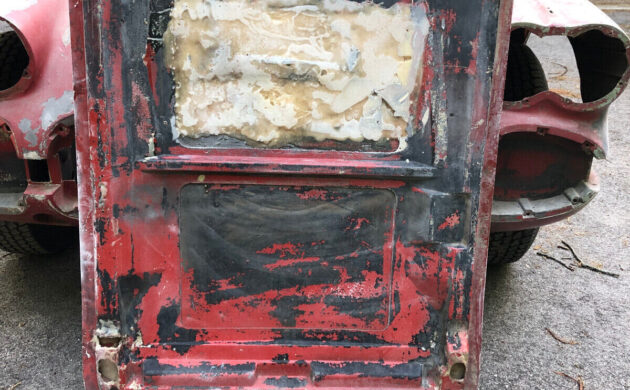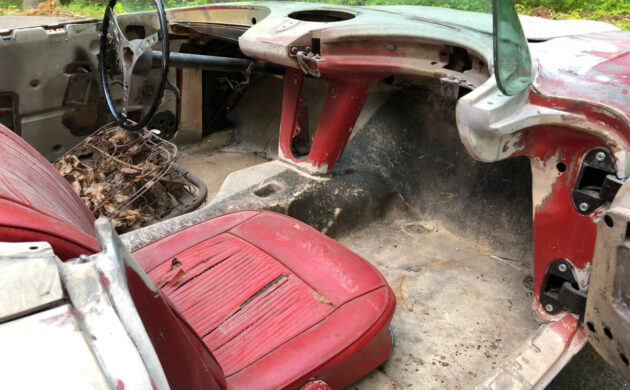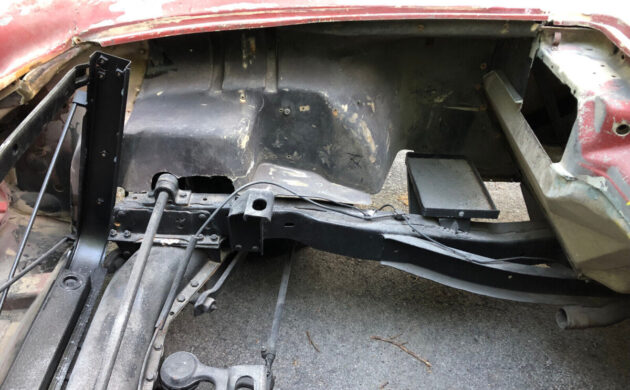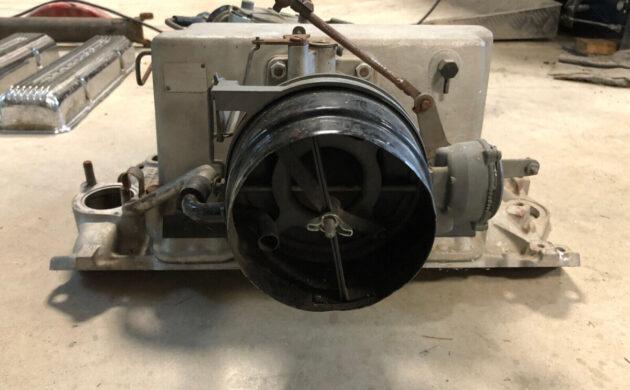Corvette prices are set by several factors, but they can be boiled down to these essentials: condition, rarity, options, and originality. An original car in perfect shape, but with few desirable options can demand a high price but will never hit that next level. Conversely, a collector will pay insane money for a car with the right options that is in deplorable shape. That may be the case for this 1962 Corvette for sale on eBay in Greenville, New Hampshire. This long-delayed restoration project is quite rough around the edges. It does, however, have one of the most desirable options in Corvette history: fuel injection. Is this corn cob rough Roman Red Corvette worth much more than the current bid of $20,100? Would you rather have a car in better condition for less overall money, or is the fabled fuelie worth the premium?
The story on this Corvette is a familiar one. According to the seller, this car was purchased from a National Corvette Restorers Society member 13 years ago as a project. From the brief description, it seems that the seller and his fiancé were starry-eyed partners in crime in picking up this classic Corvette. The NCRS member had started a restoration on the car, and they promptly sent it to a body shop to be restored. That body shop guy closed up shop and the car ended up living in their garage ever since.
It would be reasonable to assume by the pictures and the number of parts that aren’t in those pictures that this was an incomplete car to start with. Either the restorer or the body shop person started to sand the car down. When you sand down a Corvette and get a look at what is under the paint, you are kind of an automotive archaeologist. You can see every bump, bruise, wreck, proper repair, botched patch-up job, and even how the factory bonded multiple pieces of fiberglass together to build the car. Getting behind the Roman Red paint on this car must have been fascinating because it has obviously lived a life of adventure. Garage queen Corvettes are a thing now, but back in the day many of these cars were driven hard. This one was no exception.
During that storage time, the seller picked up a 1961-1962 nose from someone and grafted it on the car. There is no mention of where the original went off to, or if it was even present when they bought the car. The very rough hood you see above was a swap meet find believed to be correct for the year of the car. On the good side, the car has both a fiberglass hard top and a convertible top assembly. Numerous parts are not currently attached but go with the car. The ad lists such things as sill plates, the speedometer cable, the heater box, the instrument cluster, and a plethora of other small parts.
Inside we see both seats, although the driver’s seat is in rough condition compared to the not-so-great passenger seat. On the good side, the floors look to be free from damage and the door hinges may already have been refurbished. A close look at the windshield shows that it is just sitting on top of the cowl for display purposes. Thankfully the windshield frame will be included with the sale.
Under the hood, we see several issues and some good points. There are numerous rough spots in the fiberglass. The cutout by the roll bar and the area in the front part of the engine bay look to have been handled in a not delicate way in the past. The frame is a good point it seems. Take away the layer of dust and we might find that the frame has already been restored. The battery tray looks uncharacteristically new, as does the support in the front of the engine bay.
The picture above is the exact reason why this car has garnered so much interest. In the ad, the seller claims that this is a 1962 correct fuel injection unit, complete with part number and serial number. Also included in the sale are several fuelie specific engine parts. Sadly, there is no block nor are there any cylinder heads to go with the sale. The case for this car actually being a fuel-injected car is not made in the ad. If any of our readers can give us some clues as to what a prospective buyer might look for to prove that it is a legitimate fuelie, we would appreciate that information being posted in the comments.
We are told that the car has sold a few times, but the buyers have backed out to the point that the seller is frustrated. While a deal is a deal and should be honored, this may be a case of folks realizing they have bitten off more than they can chew. This seems to have been the case for the seller. Restoring an early Corvette to perfection is no easy or quick task. It takes a lot of work, dedication, and folding money to get one to the finish line. If you are up to the task, this may be a bargain.
Is this a project car you would tackle? Please tell us why or why not in the comments.











You would be buying an FI unit with the car thrown in. Good luck and Godspeed.
Actually, you are buying PART of an FI unit.
Just needs too much of everything. Perhaps why the seller says it has been ‘sold’ several times.
This car isn’t a viable project, even for an expert rebuilder. It just needs too much.
You can buy an injected ’62 Corvette with its original drivetrain for less than $100,000. It would cost much more than that to restore this one with a replacement drivetrain.
I think the seller should drop the reserve and take the current high bid. Even being generous, I don’t see more than $15,000 worth of parts here.
The body alone will bring $15K to a resto-mod builder.
wouldn’t the VIN tell you if this was a fuelie or not?
No. There are no indications in the ad photos that this car was factory injected.
The 340 hp engine used the same tach. The FI tach drive cable hole in the firewall isn’t shown in the photos. Assuming the fiberglass fenderwells are original to this car, none of the FI indicators are there.
In this condition, you could go your own way and create something outrageous. Go electric? A safari version? Drop in a Falconer V12 perhaps?
I think the NCRS prior owner took advantage of this person.
Its a parts car at best or just a future LS drop hot rod.
“Tis’ but a flesh wound…”
In March, 1974 I bought a 61 in similar condition, it had almost all the parts, (LR bumper was missing, as well as a couple pieces of door trim) most in the trunk, but no motor or trans.
I paid $500 for it which i thought was kinda high.
Doing all my own work, I had about $7K in it by 1980 when it had been passably restored, except for having the stainless trim straightened and polished,
Now on its third restoration, I have about $50K total in the car, not counting the cost of the 427 Gen 1 small block Injected motor.
https://www.dropbox.com/s/vul9i806fvc31ef/1974vette1.jpg?dl=0
https://www.dropbox.com/s/p4ir76bheff6cnh/Sept2018b.JPG?dl=0
This ’62 car, would need an owner that is very hands on, and complete list of what parts are there and of those, what are usable in order to figure out if this is feasible as a labor of love, it isn’t profit making project, though.
F it’s an original fuelie, the windshield washer tank will be on the passenger side. Also, on a 62 only, there are two dimples on the firewall where the tach drive cable passes through. It’s been too many years, and I can’t remember which, but one was for the FI distributor and the other for the non FI. This is a foolproof way to identify an original 62 fuel car. I wrote a magazine article about this years ago, but my memory has failed me. I’m sure a google search can unearth the info.
The injection may be worth more than the car! I think if you wanted a “RESTOMOD” this could be the car. I don’t think even making it a correct fuel car would be cost effective. This is simply a six figure plus undertaking no matter what you do. If money doesn’t count good luck with that,
good candidate for a resto mode, these cars (1962 vette I have one it’s done) if not complete can be a challenge, time, and how much do you want to spend, if that’s OK go for it! but a resto mode will be a better car in the end.
I can buff that out!
“…Is this a project car you would tackle? Please tell us why or why not …”
Y:
I like them, only ’56/60 (& ’63 hrd top ‘split’) tho, like the ‘coved’ doube dash, has the 2 tops, like the blue flame motor and 4 speed auto (incorrect to yr motor and OD transmission)
Not:
this is wrong yr as the correct duck’s a$$ is there, too expensive for a ‘roller’,
So ultimate answ? “no”
Gimmie the right yrs, right price, no drive train & I’d do the above (for a keeper, not sales) to have a vert in the line up again.
O lets just burn it to ground a bunch of Monday morning quarterbacks looks like most of the parts are there the fuel injection was a headache go with a small block chevy and carb etc step up or step back getter back on the road.
With insane prices of a much more desirable 63 SWC, this 62 is not for the faint of heart. Just a terrible driving car even when done.
there is still some chrome left sell that and turn it into a drag strip car. or you can grind it up and turn it into corvette brittle . then take the corvette brittle to spread it around the flower garden at the local wrecking yard. now that would be compost…
The fuel unit alone 20 years ago restored would sell for $12k alone. I agree with some that this is a major project. If you want it correct it will cost big money. The c1 car didn’t come with trim tags. You would need NCRS books to determine what it would take to make it a true fuel car. Parts for these cars could cost big money. The $20k bid barely covers the cost of the fuel unit, frame, body and title. Do the math $20+ is a bargin but is it worth the headache to restore?? Resto mod cheaper way to go if your not a NCRS person. Small blocks are everywhere cheap. Body shops and trustworthy shops are hard to find. I would do the resto mod and set my bid at $25kmax. It will only go up in value, there were NEVER many vettes made in the c1’s.
Piece it together with used crappy parts, put a 350 crate motor in it and enjoy it as a very used car. It would get a lot of looks and you would care as much if it got hit. Also I am tired of seeing the 50’s and 60’s cars as museum pieces and investment items. They were meant to be driven. This is the perfect candidate for that.